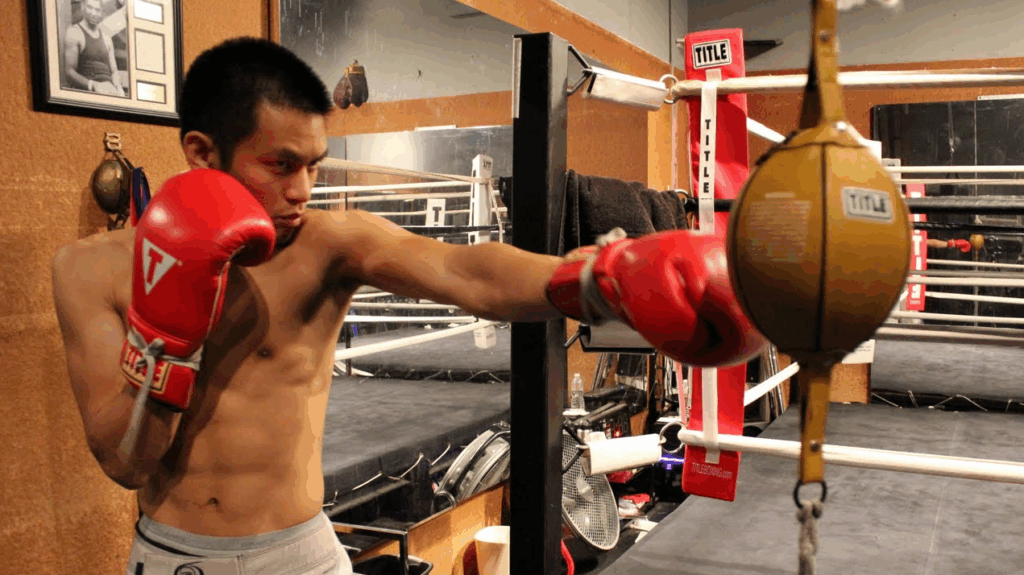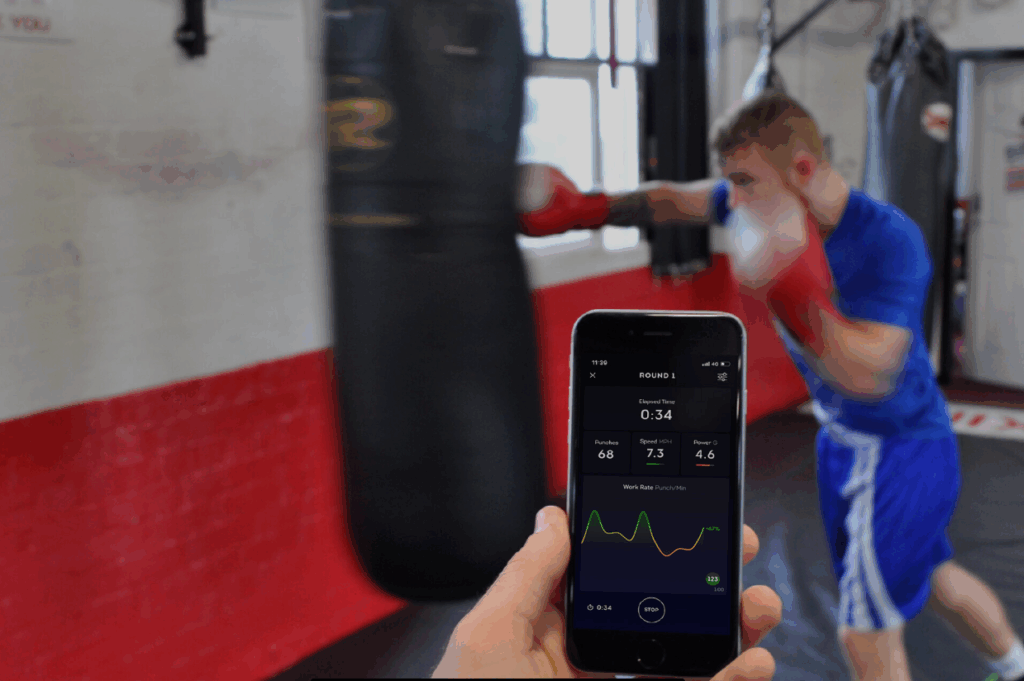Sharpen your boxing reflexes through eight proven hand-eye coordination drills that transform how quickly you spot and exploit openings. Start with reaction ball drops to challenge split-second visual processing, then progress to speed bag work for rhythm and timing. Add tennis ball wall throws, focus mitt drills, double-end bag training, shadowboxing with visual cues, color-coded pad combos, and slip cord drills with targets.
Master these techniques to develop lightning-fast counterpunch timing that’ll leave opponents stunned.
What Is Hand-Eye Coordination in Boxing?
Two critical systems work together when you throw a punch: your visual processing and motor control. Hand-eye coordination in boxing means your brain processes what you see and instantly translates it into precise movements. This visual-motor coordination determines whether you’ll land clean shots or miss them entirely.
Your neuromuscular control activates when you spot an opening, triggering a complex chain of signals from your eyes to your brain and then to your muscles. This brain-body synchronization happens in milliseconds, making reaction time enhancement pivotal for both offense and defense.
When you’re tracking your opponent’s movements while simultaneously planning your next strike, you’re engaging in multiple neurological pathways. These pathways strengthen with practice, allowing you to react faster and strike more accurately during high-pressure situations.

Benefits of Hand-Eye Coordination Drills
Sharp hand-eye coordination transforms average boxers into elite fighters by accelerating your reaction speed beyond what most opponents can match. Through consistent reflex training, you’ll develop lightning-fast counterpunch timing that catches opponents off guard. Working with tools like the reaction ball sharpens your visual processing, while focus mitts enhance your targeting precision under pressure.
Your defensive game improves dramatically as eye tracking becomes second nature during shadowboxing sessions. You’ll slip punches instinctively, reading subtle body cues before strikes launch. Head movement flows naturally when your eyes and body sync perfectly.
Beyond physical benefits, these drills sharpen mental focus during intense sparring rounds. You can maintain composure when chaos erupts, processing multiple threats while executing clean combinations. Your heightened awareness separates champions from contenders in the ring.

Top Drills to Improve Coordination and Reflexes
You’ve learned why hand-eye coordination matters, but now it’s time to put theory into practice. These eight proven drills will sharpen your reflexes and transform your boxing performance through targeted visual and motor skill training.
Reaction Ball Drops
While traditional boxing drills build power and technique, reaction ball drops specifically target the split-second visual processing that separates good fighters from great ones. You’ll drop a six-sided reaction ball from shoulder height and catch it after one bounce, forcing your eyes to track its unpredictable path.
This sensorimotor training challenges your reflexes because the ball’s irregular shape creates random bounces. Start with single catches, then progress to alternating hands or incorporating defensive movements between drops. You’re training your brain to process visual information faster while maintaining body control.
For advanced work, have a partner drop the ball from different angles while you maintain your boxing stance. It mirrors the visual tracking demands of following an opponent’s punches, directly improving your reaction speed in the ring.
Speed Bag Work
The rhythmic pop-pop of a speed bag creates one of boxing’s most recognizable sounds, but this classic tool does more than build shoulder endurance. You’ll develop exceptional hand-eye coordination as you track the speed ball’s rapid movements and strike it precisely at the right moment.
Begin with steady, deliberate swings to find your rhythm. Keep your eyes fixed on the ball and aim for a consistent pace between each strike. As you progress, you’ll notice your arm-eye sync improving dramatically.
Try alternating between single and double strikes, then incorporate cross-hand patterns. The speed bag’s unpredictable rebounds force you to adjust your positioning and timing constantly. This real-time adaptation translates directly to improved reflexes during sparring, where split-second adjustments make the difference between landing clean shots and missing entirely.
Tennis Ball Wall Throws
After mastering the speed bag’s rhythm, tennis ball wall throws challenge your tracking abilities in a completely different way. Sharpen your depth perception and quicken your hands by repeatedly throwing a tennis ball at a wall and catching it on the rebound. Start with single-hand catches, then progress to alternating hands and varying throw angles.
This drill enhances your movement accuracy as you adjust your body position to track the ball’s unpredictable rebounds. Your reflex development accelerates when you increase throwing speed and distance. For combat sports performance, add footwork patterns while catching to mimic ring movement.
The constant visual tracking translates directly to target accuracy during combinations. You’re training your brain to process moving objects faster, improving precision striking against elusive opponents. Practice 3-5 minutes between rounds for ideal results.
Focus Mitt Reflex Drills
Focus mitt drills transform your reaction speed by forcing split-second decisions under pressure. When your trainer randomly flashes mitts at different angles, you’ll develop lightning-fast recognition and striking accuracy. These boxing drills demand intense concentration as you track moving targets while maintaining proper form.
You’ll enhance defensive agility by incorporating head movement between combinations. Your trainer can simulate incoming punches, requiring you to slip or weave before countering. It mirrors real fight scenarios where you must defend and attack seamlessly.
Start with basic jab-cross patterns, then progress to complex sequences with verbal or visual cues. Mix in body shots and uppercuts to challenge different reaction pathways. The unpredictability keeps your nervous system sharp, translating directly to improved ring performance.
Double-End Bag Drills
While focus mitts test your reactions against a moving partner, double-end bags challenge your timing against an unpredictable solo opponent. This small, fast-moving bag rebounds erratically after each strike, forcing you to track its movement while maintaining defensive awareness.
Start with basic jabs, focusing on clean contact as the bag swings back. You’ll quickly discover that power isn’t key. Precision is. Miss your target, and you’re left off balance and exposed. As you improve, incorporate combinations and head movement between strikes.
The bag’s constant motion trains your eyes to process rapid, directional changes while your hands execute accurate punches. Work in two-minute rounds, mixing straight punches with hooks and uppercuts. This drill simultaneously sharpens offensive accuracy and defensive reflexes, making it invaluable for complete skill development.
Shadowboxing with Visual Cues
The double-end bag demands reactive precision, but shadowboxing with visual cues builds proactive decision-making skills. Set up colored cards or lights around your training space. As you shadowbox, respond to specific colors with predetermined combinations. Red triggers a jab-cross, blue means slip and counter, and green signals an uppercut series.
This drill forces you to process visual information while maintaining form and footwork. You’ll develop split-second decision-making that mirrors real fight scenarios.
Start with simple two-punch combos, then progress to complex sequences. Add a partner who randomly flashes colors to increase unpredictability. You can also use a smartphone app that displays colors at random intervals. The key is maintaining fluid movement while your brain rapidly processes visual input and executes the correct response.
Color-Coded Pad Combos
Most boxing coaches overlook how color-coded pad combos can transform your selective attention and striking accuracy. Like shadowboxing, assign specific punches to different colored pads. You can use red for jabs, blue for hooks, and yellow for uppercuts. Your partner randomly presents pads while calling colors, forcing you to process visual and auditory cues simultaneously.
This drill sharpens your brain’s ability to filter distractions and execute the right punch instantly. You’re training neural pathways to connect color recognition with motor patterns under pressure. Start with two colors and basic punches, then progress to four-color sequences with complex combinations. You can’t anticipate which pad appears next. You’ll develop razor-sharp focus and eliminate hesitation between seeing a target and striking it accurately.
Slip Cord Drills with Targets
Building on color recognition skills, slip cord drills add reactive movement patterns that mirror real fight scenarios. Set up a rope at eye level, attaching small targets like tennis balls or foam pads at various points. As you slip under the cord, you’ll strike specific targets your coach calls out, forcing split-second decisions while maintaining defensive positioning.
This drill sharpens your ability to evade punches while simultaneously identifying counterattack opportunities. You’re training your brain to process multiple visual cues. The cord represents incoming strikes, and the targets as openings. Start slowly, focusing on clean slips and accurate strikes. Gradually increase speed as your coordination improves.
Advanced variations include adding footwork patterns or having a partner randomly move targets, demanding constant visual tracking and adjustment.
How to Program These Drills
Once you’ve mastered these coordination drills, you’ll need a structured approach to integrate them into your training routine. For beginners, practice 2-3 drills per session, three times weekly. Advanced boxers can handle 4-5 drills four to five times per week.
Add coordination work after your warm-up but before heavy bag training. This timing guarantees you’re alert but not fatigued. Keep drill sessions between 15-20 minutes total.
For solo work, focus on reaction balls, speed bags, and wall throws. Partner drills like focus mitts and color-coded pads work best during dedicated technique sessions. Rotate drills weekly to prevent adaptation and maintain the challenge.
Common Mistakes to Avoid
Training hand-eye coordination in boxing can backfire if you unknowingly develop poor habits that limit your improvement. The biggest mistake is rushing through reps without maintaining focus. Speed means nothing if you’re not processing visual cues properly. Slow down and prioritize accuracy first.
Don’t neglect footwork while training your hands and eyes. Your stance and movement create the foundation for every punch and defensive maneuver. Practice drills with proper foot positioning to build complete coordination.
Overtraining is another trap. High-speed reaction drills tax your nervous system. Without adequate rest between intense sets, you’ll develop sloppy patterns instead of sharp reflexes. Give yourself 30-60 seconds between demanding exercises. Quality beats quantity when you’re rewiring neural pathways for faster boxing reactions.
Progress Tracking and Adaptation
Now that you’re avoiding common pitfalls, you need a system to measure your improvement. Film yourself performing drills weekly to spot subtle changes in speed and accuracy. Use a metronome or timer to track how many successful reps you complete in 30-second intervals.
As you progress, increase the difficulty systematically. Start reaction ball drops from chest height, then progress to overhead. Add multiple tennis balls for wall throws. Incorporate feints into focus mitt work. For double-end bag drills, decrease bag size or increase striking combinations.
Advanced boxers can use reaction sensors that measure response time in milliseconds. Apps with visual stimuli tests provide objective data on your reflexes. When you’re consistently hitting 90% accuracy on current drills, it’s time to introduce new variations or increase speed requirements.

Frequently Asked Questions
Can Hand-Eye Coordination Drills Help With Weight Cutting or Conditioning?
While hand-eye coordination drills are not for weight cutting, they’ll boost your conditioning through constant movement and mental engagement. You’re burning calories during fast-paced drills, but they won’t replace dedicated cardio for weight management.
Do Professional Boxers Practice These Drills Daily or Weekly?
You’ll find most pros incorporate these drills 3-5 times weekly, not daily. They’ll prioritize quality over quantity, often including 10-15 minutes during warm-ups or dedicated skill sessions to maintain sharp reflexes without overtraining.
Will These Exercises Improve My Sparring Performance Against Southpaws?
Yes, you’ll notice significant improvements against southpaws. These drills enhance your ability to track unconventional angles and react to reversed stances. You’ll adapt faster to their opposite movements and land cleaner counters during exchanges.
Can I Do Coordination Drills While Injured or Recovering?
You can definitely do modified coordination drills while recovering. Try seated tennis ball catches, visual tracking exercises, or slow-motion shadowboxing movements. Always consult your doctor first and avoid anything that aggravates your specific injury.
Do Hand-Eye Drills Transfer to Other Combat Sports Like MMA?
Yes, you’ll find these drills transfer excellently to MMA, kickboxing, and martial arts. They’ll improve your striking accuracy, defensive reactions, and ability to track opponents’ movements across all combat sports you practice.




